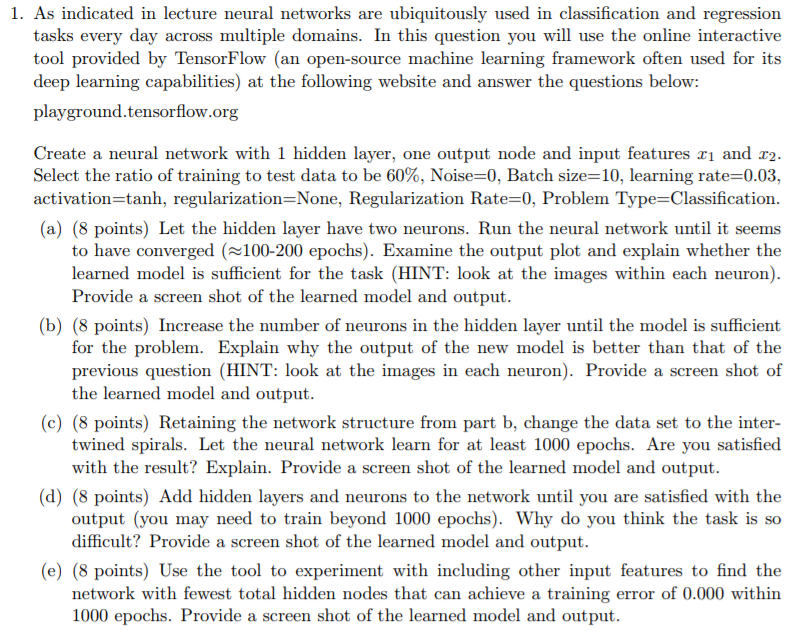
1. As indicated in lecture neural networks are ubiquitously used in classification and regression tasks every day across multiple domains. In this question you will use the online interactive tool provided by TensorFlow (an open-source machine learning framework often used for its deep learning capabilities) at the following website and answer the questions below: playground.tensorflow.org Create a neural network with 1 hidden layer, one output node and input features r1 and r2. Select the ratio of training to test data to be 60%. Noise=0, Batch size=10, learning rate=0.03. activation anh, regularization=None. Regularization Rate-0, Problem Type-Classification. (a) (8 points) Let the hidden layer have two neurons. Run the neural network until it seems to have converged (100-200 epochs). Examine the output plot and explain whether the learned model is sufficient for the task (HINT: look at the images within each neuron) Provide a screen shot of the learned model and output. (b) (8 points) Increase the number of neurons in the hidden layer until the model is sufficient for the problem. Explain why the output of the new model is better than that of the previous question (HINT: look at the images in each neuron). Provide a screen shot of the learned model and output (c) (8 points) Retaining the network structure from part b, change the data set to the inter- twined spirals. Let the neural network learn for at least 1000 epochs. Are you satisfied with the result? Explain. Provide a screen shot of the learned model and output (d) (8 points) Add hidden layers and neurons to the network until you are satisfied with the output (you may need to train beyond 1000 epochs). Why do you think the task is so difficult? Provide a screen shot of the learned model and output (e) (8 points) Use the tool to experiment with including other input features to find the network with fewest total hidden nodes that can achieve a training error of 0.000 within 1000 epochs. Provide a screen shot of the learned model and output 1. As indicated in lecture neural networks are ubiquitously used in classification and regression tasks every day across multiple domains. In this question you will use the online interactive tool provided by TensorFlow (an open-source machine learning framework often used for its deep learning capabilities) at the following website and answer the questions below: playground.tensorflow.org Create a neural network with 1 hidden layer, one output node and input features r1 and r2. Select the ratio of training to test data to be 60%. Noise=0, Batch size=10, learning rate=0.03. activation anh, regularization=None. Regularization Rate-0, Problem Type-Classification. (a) (8 points) Let the hidden layer have two neurons. Run the neural network until it seems to have converged (100-200 epochs). Examine the output plot and explain whether the learned model is sufficient for the task (HINT: look at the images within each neuron) Provide a screen shot of the learned model and output. (b) (8 points) Increase the number of neurons in the hidden layer until the model is sufficient for the problem. Explain why the output of the new model is better than that of the previous question (HINT: look at the images in each neuron). Provide a screen shot of the learned model and output (c) (8 points) Retaining the network structure from part b, change the data set to the inter- twined spirals. Let the neural network learn for at least 1000 epochs. Are you satisfied with the result? Explain. Provide a screen shot of the learned model and output (d) (8 points) Add hidden layers and neurons to the network until you are satisfied with the output (you may need to train beyond 1000 epochs). Why do you think the task is so difficult? Provide a screen shot of the learned model and output (e) (8 points) Use the tool to experiment with including other input features to find the network with fewest total hidden nodes that can achieve a training error of 0.000 within 1000 epochs. Provide a screen shot of the learned model and output







